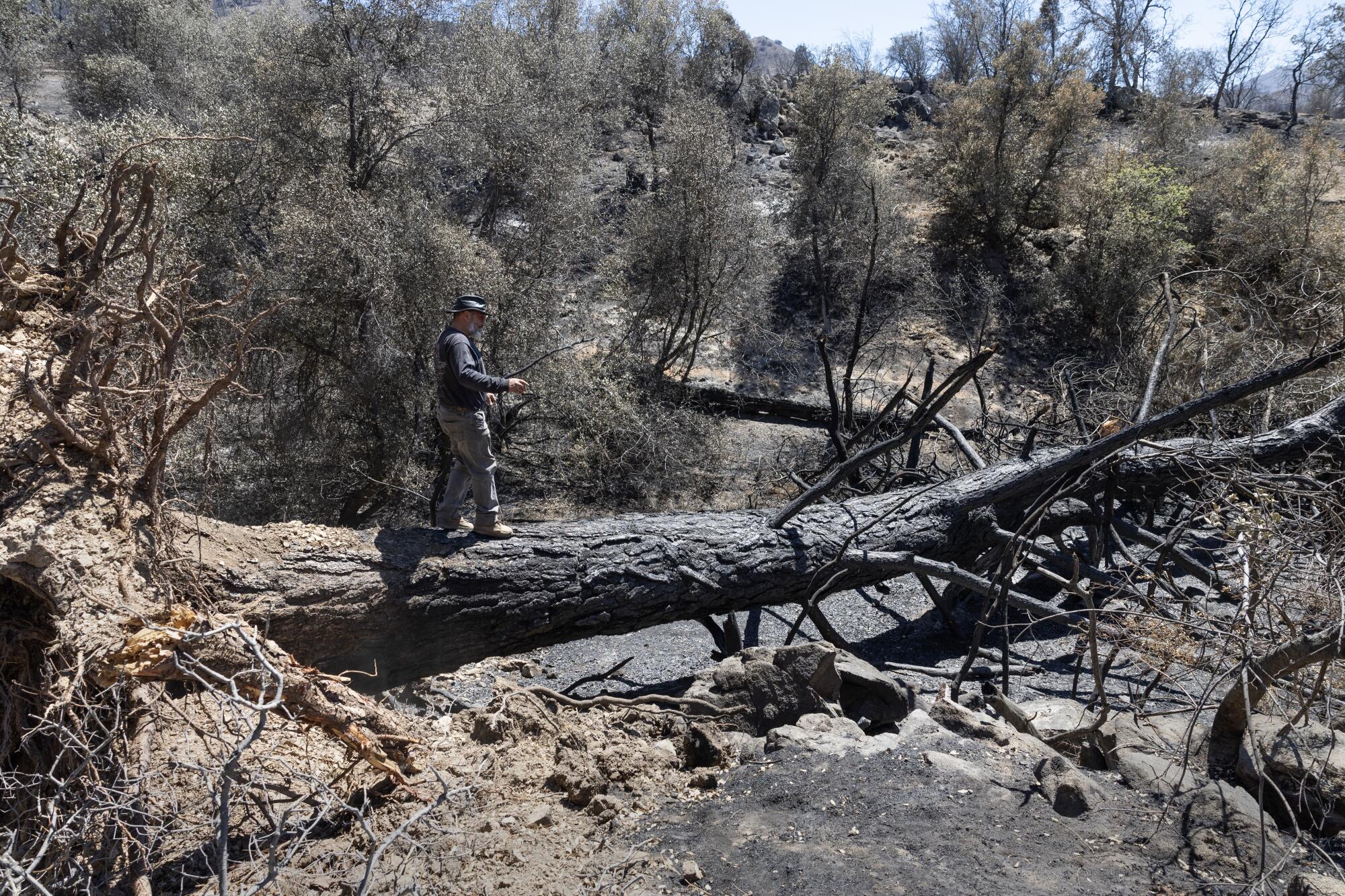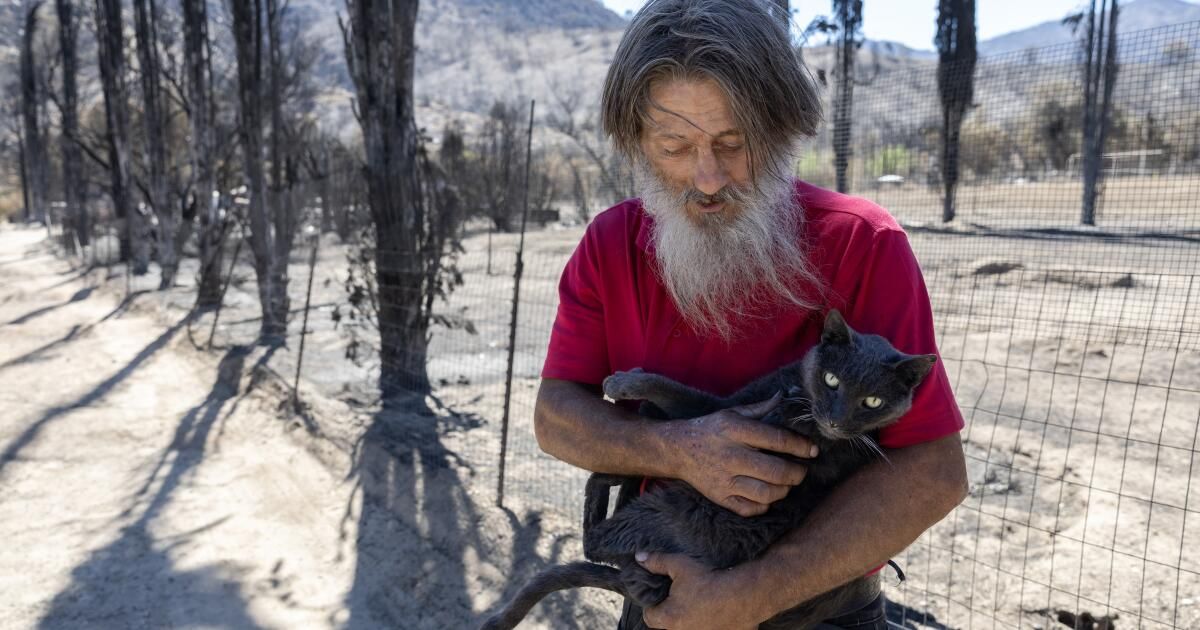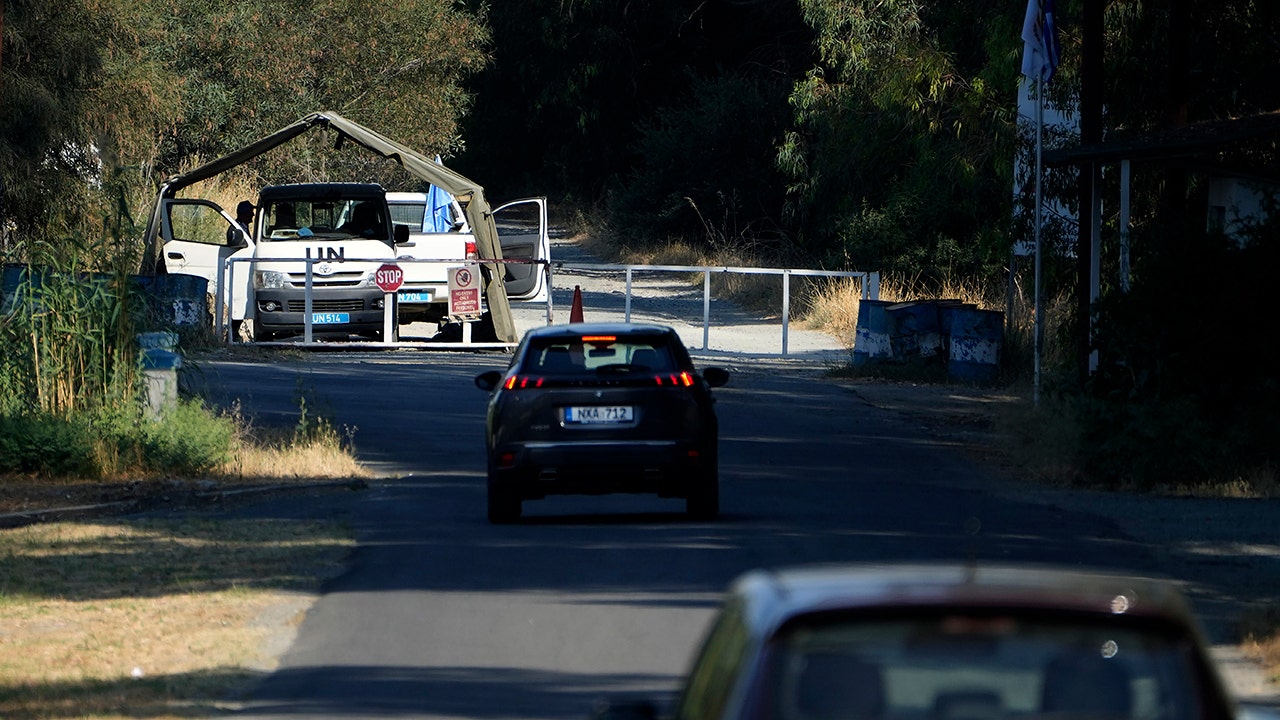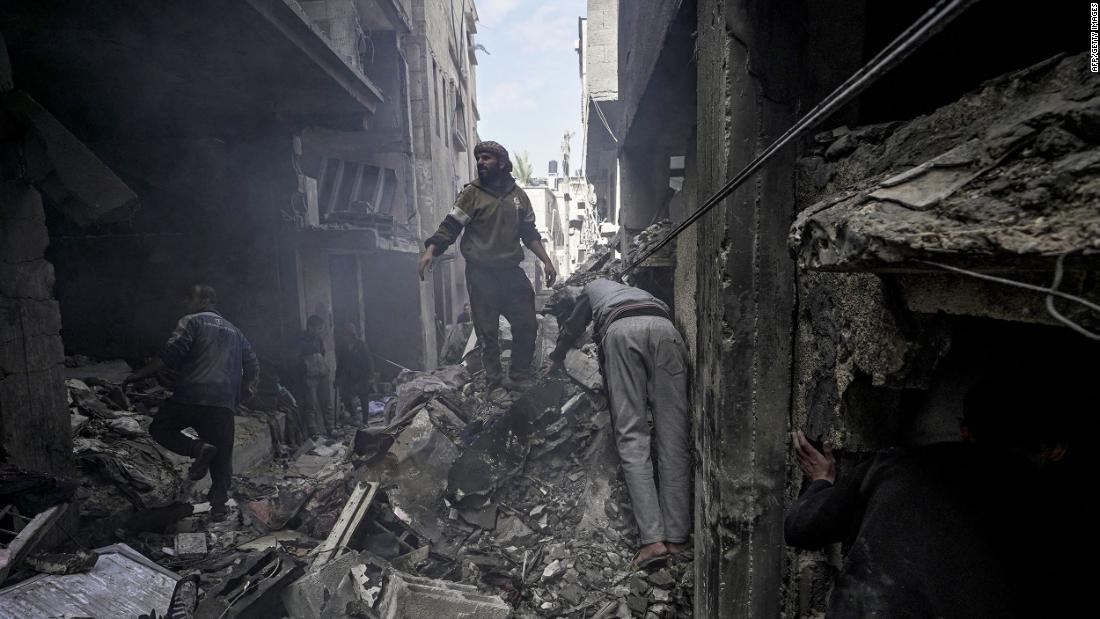It's hard to put into words the mix of fear and dread Daniel Gonzales felt when a wind-whipped wildfire swept through his yard last month in this remote mountain town in eastern Kern County. He managed to get out with two cats before the flames engulfed his home. But a third cat, Fat Ass, ran out the door before Gonzales could get him into a cage.
Last week, Gonzales returned to his home of 36 years, overwhelmed by the loss. He pointed to the charred cars he had been fixing up to sell. The metal skeletons of Harley-Davidsons melted into the ground. His house, with its stamp and coin collections, disintegrated.
“I want my house back. I want my cats back,” said Gonzales, 64. “Everything I had burned down. Everything I had to make money off of was gone.”
And just then, a precious piece of home trotted out of the ashes.
“Look who heard your voice,” Gonzales neighbor Justice Daniels shouted.
“Oh!” Gonzales exclaimed, turning around. “Is that Fatso? Hi, Fatso!”
Daniel Gonzales discovers that his missing cat, Fat Ass, survived the ravages of the Borel fire.
Nearly three weeks after the fire, there was a glimmer of hope for Gonzales, who like most of Havilah's 150 residents is trying to chart a way forward after the Borel fire burned the historic mining town to the ground.
The wildfire, which began July 24, went down in history as Kern County’s largest, burning nearly 60,000 acres. As of Monday, the fire was still smoldering but was 94% contained. Its path of destruction razed more than 200 structures, extending an unusually intense fire season that is straining county resources.
It looks like it's Kern County's turn to experience a summer of wildfires. And summer isn't over yet.
“By June 12 of this year, we had already seen more acres burned in Kern County than in all of 2023 combined,” said Capt. Andrew Freeborn of the Kern County Fire Department. “The frequency of fire activity spans every corner of our county.”

Breckenridge Mountain is obscured by smoke from the Borel Fire, which became the largest wildfire in Kern County history.
(Robert Gauthier/Los Angeles Times)
Freeborn said two years of relatively heavy rains had spurred dense vegetation growth that has now dried out and become abundant fuel for wildfires. Havilah sits among rugged, grassy hills that have turned yellow in the summer heat.
Spanning more than 8,000 square miles, Kern is the state's third-largest county by land area and encompasses a diverse topography, from arid deserts to scrubby grasslands to mountain forests. The county has already recorded 850 wildfires this year, far exceeding those of previous years, Freeborn said. Most have been small, while some like Borel have exploded and forced thousands of people to evacuate. At one point this summer, the county battled three forest fires at once.
“For some, like Borel, it doesn't matter how many [firefighters] “If you get up there,” Freeborn said, “Mother Nature is far more powerful than anything we can throw at her.”
The U.S. Forest Service is still investigating the Borel Fire and has not released an official cause. However, local authorities believe the blaze could be linked to a fatal car accident that sparked a vegetation fire.

“My heart is broken,” says Sergio García about the burned houses and scorched landscape left in the wake of the Borel fire.
Alexis Henderson was working at an Amazon warehouse more than an hour away when she heard the Borel Fire was moving through the mountains toward her home in Havilah. Her fiancé’s mother was there caring for Henderson’s 19-month-old daughter, Lisa, and they were being evacuated.
Henderson, 23, had arrived from Arkansas less than a year earlier. She lived in a trailer with her fiancé, on land they shared with her fiancé's mother. The fire destroyed the trailer and everything inside, including Lisa's birth certificate.
Henderson said that because she doesn’t have utility bills in her name, she’s had trouble submitting proof of residency documents needed to access government relief funds. She and her fiancé work the night shift at Amazon, but went two weeks without pay after the fire displaced them and have been moving from motel to motel.
“Right now… I don’t have any funds,” Henderson said. “We’re in trouble.”

“It was beautiful,” Roy Rede says of the animal ranch he and his partner had created in Havilah. “Now it’s just an ugly, charred mess filled with debris.”

Roy Rede and his business partner, Kirk Clark, had just minutes to load as many animals as they could into their truck and trailer as the Borel Fire raged on.
About two miles north, Roy Rede and his business partner, Kirk Clark, were creating their dream animal ranch on 30 acres in Havilah when the fire struck.
They had dogs, chickens, geese, swans and baby peacocks on the property, which they had purchased from a long-time resident whose parents had hand-built the two-room red house. And they had just secured lumber for an alpaca barn.
As the fire raced forward, they had just minutes to load as many animals as they could into their truck and trailer, Rede said. He watched through the home’s security system as the screen turned orange and flames engulfed the property. They retreated to Rede’s second home in Lake Isabella, where they kept the animals in cages until they could decide on next steps.
Miraculously, the large dogs they were unable to save survived, but the fire destroyed their home, along with rabbits and chickens.
“It was beautiful,” Rede said. “Now, it’s just an ugly, charred mess filled with debris.”
The animals are now back on the property and Rede stopped by last week to feed and water them. He said he and Clark had invested their savings in the ranch and planned to retire there. It was not insured, he said, because they were still in the process of bringing it into compliance.
Rede, a semi-retired Hollywood production designer, said he and Clark plan to rebuild. Rede will return to work and they have launched a GoFundMe campaign in hopes of recouping their losses.
Rede has received an outpouring of support from her neighbors, Sergio Garcia and his wife, Marni Phillips, whose home survived. Rede was touched when the couple stopped by with a water tank for the animals.
“There are no neighbors like that in the city,” he said.
“My heart is broken,” Garcia said, looking out at the blackened hillsides. “I love these people. These are people we’ve shared bread with. How do you tell someone your house is still standing and theirs isn’t?”
Rede looks ahead, plants new roses and waters the remaining burnt trees. The desert willows are already showing signs of life.
“Even though they are charred, new leaves are sprouting from all of them,” he said. “So there is hope.”

In its heyday, Havilah was a busy mining town where gold seekers searched for precious metals. The Borel fire incinerated much of what remained of its historic buildings.
But for many other residents who have exhausted available help from the government and the Red Cross, anger and frustration continue to mount. Gonzales has launched a GoFundMe campaign to try to get back on his feet, but for now he sleeps hunched over in the front seat of his pickup truck. His cats sleep in a cage in the back.
He wonders what he will do to earn money, saying that at his age it is difficult to find work.
But for a moment last week, he took comfort in holding Fat Ass, who licked his hand. The cat had an injured paw and was thinner than Gonzales remembered, but seemed largely unharmed.
In his truck, Gonzales had cans of wet cat food. Hopefully, within days, Fat Ass would be back in shape.












